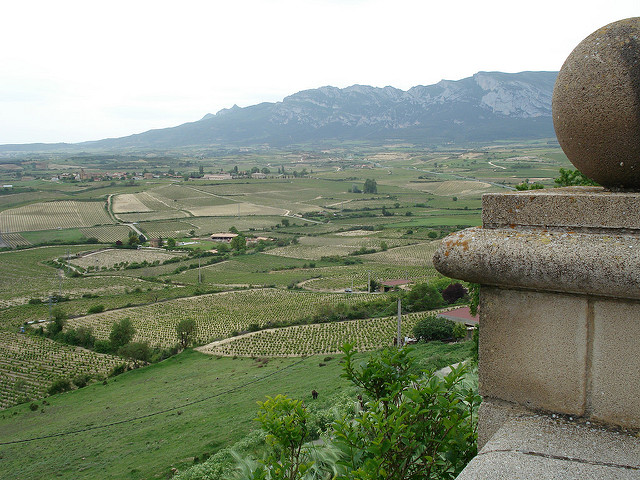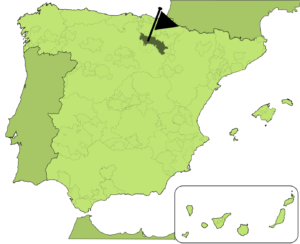[mp_row]
[mp_span col=”12″]
[mp_heading]
Cotas Altas Santalba
[/mp_heading]
[/mp_span]
[/mp_row]
[mp_row]
[mp_span col=”12″]
[mp_row_inner]
[mp_span_inner col=”9″]
[mp_tabs padding=”20″]
[mp_tab id=”55b22216423a1″ title=”The wine” active=”false”]
 Two great Spanish grapes!
Two great Spanish grapes!
Made of a special blend of 60% Tempranillo & 40% Garnacha from selected vineyards located high up on the northern slopes (780-820 m. above the sea level) in order to alleviate the effects of the climate change on viticulture and vine growing. The slow ripening of the grapes gives the wine a fresh and fruity aroma, light body and reduced alcohol content.
Red in colour with some garnet tones. In nose nice floral fragrances and some hints of raspberry. In moth red fruit explodes across the palate thanks to a well balanced acidity. A spicy taste reminding of the versatility of Garnacha in Spanish wines, earthiness envelops the palate as the fruit shows off notably at the end.
Alcohol: 12.5% Vol.
Conservation: We recommend store this wine in a cool ventilated place where the temperature is fairly constant, and keep the bottle on their side allowing the wine to be always in contact with the cork.
[button text=”Buy it online!” link=”https://www.vinosophers.com.au/santalba-cotas-altas-2015″ style=”link” size=”large” target=”_blank” display=”block” icon=”circle-arrow-right”]
[/mp_tab]
[mp_tab id=”55b22216423a2″ title=”DOCa Rioja” active=”false”]
DOCa Rioja
Rioja (Ri-o-ha) is one of only two DOs of Spain to have received the highest prestigious DOCa (Denominación de Origen Calificada) classification, this is an special recognition for this fantastic area blessed with great land to grow vines.
Rioja’s wine history dates back over 2,000 years (can you believe it?) and was ruled by Christian monks throughout the Middle Ages. In the 16th century, Rioja began to enjoy an international reputation, exporting wines to different countries as France, England, Italy, the Netherlands, and even the American colonies. As a matter of facts, it was this trade that established American Oak as the preferred wood for barrels, a tradition that remains even today.
Rioja’s wine export levels jumped dramatically when the phylloxera blight devastated French wine yields, in the mid 1850s. Rioja was able to maintain its leading exporter status even when phylloxera hit Spain in the 1890s, rapidly copying the French solution of grafting resistant American root stock to native vines. Today, Rioja remains Spain’s top exporting region.
Rioja also plays an important role in the ancient pilgrimage route the Way of Saint James and the monasteries thanks to the Roman architecture to be found alongside. It’s interesting also to note that DOCa Rioja extends northward into the Basque province of Álava, making Rioja one of the most culturally diverse wine regions in Spain.
We always like to explain DOs related with food. Wine is one of the most important companions of any dish in the healthy Mediterranean diet, and classic Rioja’s dishes include white asparagus, chorizo, suckling lamb, and Piquillo peppers, all of which pair beautifully with the elegant Rioja wines.
Rules for Rioja wine production were recorded as early as 1560, but it wasn’t until 1970 that the modern borders for Rioja were established. The region is largely contained within the northeastern Autonomic Region of La Rioja, from which it takes its name. The northern edge extends into the neighboring Autonomic Region of Navarra and País Vasco, or Basque Country. Rioja is bordered to the north by the river Ebro, which plays a key role in the region’s terroir. In fact, Rioja is named for one of the river’s tributaries, the Oja (“Rioja” deriving from “Río Oja”). The Ebro runs through the appellation’s three sub-regions—Rioja Alavesa, Rioja Alta, and Rioja Baja—each of which yields a unique expression of the Tempranillo grape.

This magnificent wine comes from the Santalba Winery, located in the sub-region called Rioja Alta. It occupies the westernmost portion of the region, with the majority of its vineyards lying south of the Ebro River. Rioja Alta centers on the historic town of Haro, where a number of very well-known wineries are located.
Rioja Alta is perhaps the most important of the three Rioja sub-regions (the others being Rioja Alavesa and Rioja Baja), both in terms of quality and the quantity of wine produced. The climate is largely similar to that of Rioja Alavesa and, as in Alavesa, the vineyards here are located at higher altitudes than in Rioja Baja, assisting in the accumulation of acidity, color and moderate alcohol levels. (Not so coincidentally, the name Rioja Alta translates to ‘high Rioja’.) The soil, although less rich in limestone than in Rioja Alavesa, has a healthy mix of clay, iron and alluvial components, giving it a redder color than its northern neighbor’s sandy white soils.
[/mp_tab]
[/mp_tabs]
[/mp_span_inner]
[mp_span_inner col=”3″]
[mp_code]
TECH NOTES

Location:
Rioja Alta, Spain.

Pairing and Consumption:
Drink with barbecues, rice dishes such as risottos, beef Carpaccio with Parmesan, beans or pulses and vegetables, pork in mustard, fresh pasta, curried chicken, Eastern and spicy dishes. Serve at a temperature of between 16-18°C .
[/mp_code]
[/mp_span_inner]
[/mp_row_inner]
[/mp_span]
[/mp_row]
[mp_row]
[mp_span col=”12″]
[mp_text]
[/mp_text]
[/mp_span]
[/mp_row]
[mp_row]
[mp_span col=”12″]
[/mp_span]
[/mp_row]
[mp_row]
[mp_span col=”12″]
[/mp_span]
[/mp_row]

